Intel's Pentium M on the Desktop - A Viable Alternative?
by Anand Lal Shimpi on February 7, 2005 4:00 PM EST- Posted in
- CPUs
Workstation Applications
Visual Studio 6
Carried over from our previous CPU reviews, we continue to use Visual Studio 6 for a quick compile test. We are still using the Quake 3 source code as our test and measure compile time in seconds.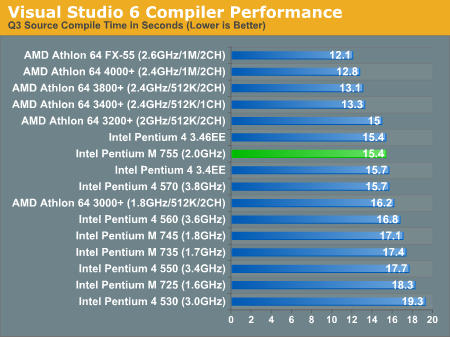
The Pentium M is very competitive with the Pentium 4 in our compiler test, but still not enough to compete with the Athlon 64.
SPECviewperf 8
For our next set of professional application benchmarks, we turn to SPECviewperf 8. SPECviewperf is a collection of application traces taken from some of the most popular professional applications, and compiled together in a single set of benchmarks used to estimate performance in the various applications that the benchmark is used to model. With version 8, SPEC has significantly improved the quality of the benchmark, making it even more of a real world indicator of performance.We have included SPEC's official description of each one of the 8 tests in the suite.
As you can guess, with the majority of performance in 3D workstation applications being determined by floating point performance and memory bandwidth, the Pentium M doesn't fare too well:
3dsmax Viewset (3dsmax-03)
"The 3dsmax-03 viewset was created from traces of the graphics workload generated by 3ds max 3.1. To ensure a common comparison point, the OpenGL plug-in driver from Discreet was used during tracing.
The models for this viewset came from the SPECapc 3ds max 3.1 benchmark. Each model was measured with two different lighting models to reflect a range of potential 3ds max users. The high-complexity model uses five to seven positional lights as defined by the SPECapc benchmark and reflects how a high-end user would work with 3ds max. The medium-complexity lighting models use two positional lights, a more common lighting environment.
The viewset is based on a trace of the running application and includes all the state changes found during normal 3ds max operation. Immediate-mode OpenGL calls are used to transfer data to the graphics subsystem."
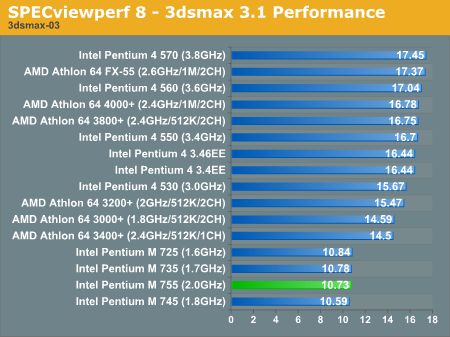
CATIA Viewset (catia-01)
"The catia-01 viewset was created from traces of the graphics workload generated by the CATIATM V5R12 application from Dassault Systems.
Three models are measured using various modes in CATIA. Phil Harris of LionHeart Solutions, developer of CATBench2003, supplied SPEC/GPC with the models used to measure the CATIA application. The models are courtesy of CATBench2003 and CATIA Community.
The car model contains more than two million points. SPECviewperf replicates the geometry represented by the smaller engine block and submarine models to increase complexity and decrease frame rates. After replication, these models contain 1.2 million vertices (engine block) and 1.8 million vertices (submarine).
State changes as made by the application are included throughout the rendering of the model, including matrix, material, light and line-stipple changes. All state changes are derived from a trace of the running application. The state changes put considerably more stress on graphics subsystems than the simple geometry dumps found in older SPECviewperf viewsets.
Mirroring the application, draw arrays are used for some tests and immediate mode used for others."
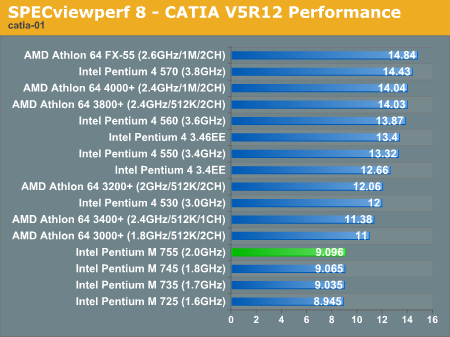
Lightscape Viewset (light-07)
"The light-07 viewset was created from traces of the graphics workload generated by the Lightscape Visualization System from Discreet Logic. Lightscape combines proprietary radiosity algorithms with a physically based lighting interface.
The most significant feature of Lightscape is its ability to simulate global illumination effects accurately by precalculating the diffuse energy distribution in an environment and storing the lighting distribution as part of the 3D model. The resulting lighting "mesh" can then be rapidly displayed."
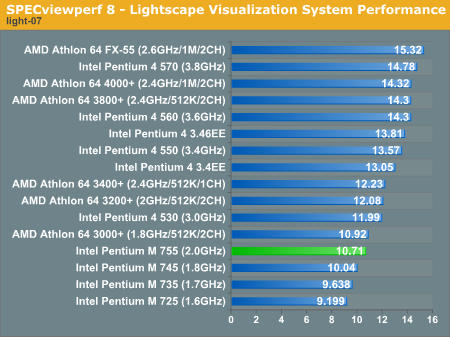
Maya Viewset (maya-01)
"The maya-01 viewset was created from traces of the graphics workload generated by the Maya V5 application from Alias.
The models used in the tests were contributed by artists at NVIDIA. Various modes in the Maya application are measured.
State changes as made by the application are included throughout the rendering of the model, including matrix, material, light and line-stipple changes. All state changes are derived from a trace of the running application. The state changes put considerably more stress on graphics subsystems than the simple geometry dumps found in older viewsets.
As in the Maya V5 application, array element is used to transfer data through the OpenGL API."
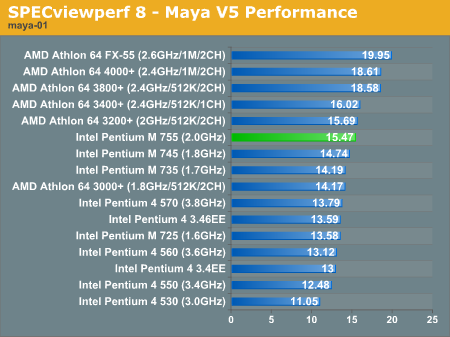
Pro/ENGINEER (proe-03)
"The proe-03 viewset was created from traces of the graphics workload generated by the Pro/ENGINEER 2001TM application from PTC.
Two models and three rendering modes are measured during the test. PTC contributed the models to SPEC for use in measurement of the Pro/ENGINEER application. The first of the models, the PTC World Car, represents a large-model workload composed of 3.9 to 5.9 million vertices. This model is measured in shaded, hidden-line removal, and wireframe modes. The wireframe workloads are measured both in normal and antialiased mode. The second model is a copier. It is a medium-sized model made up of 485,000 to 1.6 million vertices. Shaded and hidden-line-removal modes were measured for this model.
This viewset includes state changes as made by the application throughout the rendering of the model, including matrix, material, light and line-stipple changes. The PTC World Car shaded frames include more than 100MB of state and vertex information per frame. All state changes are derived from a trace of the running application. The state changes put considerably more stress on graphics subsystems than the simple geometry dumps found in older viewsets.
Mirroring the application, draw arrays are used for the shaded tests and immediate mode is used for the wireframe. The gradient background used by the Pro/E application is also included to better model the application workload."

SolidWorks Viewset (sw-01)
"The sw-01 viewset was created from traces of the graphics workload generated by the Solidworks 2004 application from Dassault Systemes.
The model and workloads used were contributed by Solidworks as part of the SPECapc for SolidWorks 2004 benchmark.
State changes as made by the application are included throughout the rendering of the model, including matrix, material, light and line-stipple changes. All state changes are derived from a trace of the running application. The state changes put considerably more stress on graphics subsystems than the simple geometry dumps found in older viewsets.
Mirroring the application, draw arrays are used for some tests and immediate mode used for others."

Unigraphics (ugs-04)
"The ugs-04 viewset was created from traces of the graphics workload generated by Unigraphics V17.
The engine model used was taken from the SPECapc for Unigraphics V17 application benchmark. Three rendering modes are measured -- shaded, shaded with transparency, and wireframe. The wireframe workloads are measured both in normal and anti-alised mode. All tests are repeated twice, rotating once in the center of the screen and then moving about the frame to measure clipping performance.
The viewset is based on a trace of the running application and includes all the state changes found during normal Unigraphics operation. As with the application, OpenGL display lists are used to transfer data to the graphics subsystem. Thousands of display lists of varying sizes go into generating each frame of the model.
To increase model size and complexity, SPECviewperf 8.0 replicates the model two times more than the previous ugs-03 test."
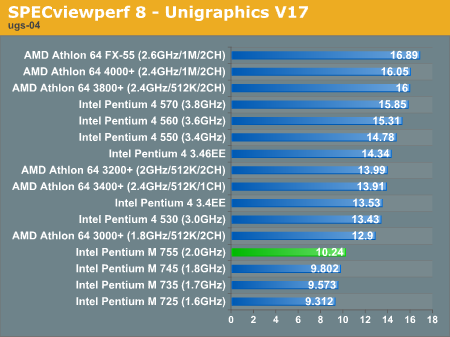










77 Comments
View All Comments
Lupine - Wednesday, February 16, 2005 - link
I'm surprised at these results. I'm setting up a new Dell Inspiron 9200 (M 725 @ 1.6GHz/400MHz FSB) and it is schooling both my Barton 2500+ @ 2.2GHz and TBred B 1700+ @ 2.2GHz running Stanford's Folding@Home project (600 point proteins: ~37min per frame for the XP boxes compared to ~34min per frame w/ the laptop).So, if it is so weak, what is allowing it to process WUs at such a competitive rate? Sure, that is slower than an A64, but competitive w/ most P4 procs.
fitten - Thursday, February 10, 2005 - link
Something else to remember about the Banias/Dothan line of chips... Agressive power reduction was the #1 goal of the design process. In a 'normal' chip design, not all pipeline stages are the same length, the clock speed it runs at is the speed of the slowest part of the CPU. Since power usage is directly related to the frequency of the switching gates, the Intel engineers actually deliberately slowed down some parts of the chip to match the target release speeds (or get close to them) to reduce power consumption. This is, perhaps, the main reason why the frequencies don't scale so well as some would want them to scale.Visual - Thursday, February 10, 2005 - link
here's another thought... when the opterons launched initially at ECC DDR266, there were similar comments like "give it unbuffered DDR400 or higher and stay out of its way" :) well, now that we have that, ok it did improve performance a bit. but not hugely. shouldn't help the dothan significantly more too.Visual - Thursday, February 10, 2005 - link
I like how AMD got beaten by the P-M :) not because im intel fan, just because this will make things more interesting now.don't catch flame from this comment :p its my oppinion
Funny how you picked the game benchmarks btw, its almost as if you wanted to show the P-M lacking behind the A64... from what I've seen it beats A64 in HL2 and CSS, and that's a game you don't skip usually :) so why now?
Also looks suspicious how in lots of tests where P-M performs well with the A64 clock-for-clock or beats it, there is almost no difference in the 3800+ and 4000+ results... like if L2 isnt all that important, yet L2 is exactly how everyone explains the P-M success
Maybe we'll see some 2MB L2 A64 "emergency edition" once Dothan gets a decent desktop chipset, just like what intel did to (try to) save P4 from the A64 :)
actually i'd be happy if Dothan motivates AMD to develop faster L2 cache or something.
Knowing Intel, i dont expect they'd even try to match AMD's prices with the P-M... and there's a lot of room for AMD to decreace prices, as they're selling with quite a margin now. So for sure the P-M won't be cost-effective compared to A64, not if you don't care for ultra-low power consumption at least.
also it doesn't look likely Dothan could scale beyond 2.6GHz on current 90nm tech. by the time it gets there, AMD should've launched the 2.8 FX and most likely 3GHz too. so I have no doubts AMD will keep the lead for quite a while... maybe the race to 65nm will be the next turning point, as it seems its going smooth for intel (at least for P-M)
anyway, even if AMD is better in absolute performance, pricepoint and (arguably) clock-for-clock, you gotta admit it to the P-M, it does quite a punch. fun times are coming :)
Zebo - Wednesday, February 9, 2005 - link
dobwal buy intel if you want mhz, AMD is for performance.dobwal - Wednesday, February 9, 2005 - link
i wasn't referring to the FX series. Plus you are not understanding the point i was trying to make. Lets take a look at the FX series.OPN Model Operating Freq. Package ADAFX55DEI5AS FX55 2600MHz 939-Pin
ADAFX53DEP5AS FX53 2400MHz 939-Pin
ADAFX53CEP5AT FX53 2400MHz 940-Pin
ADAFX51CEP5AT FX51 2200MHz 940-Pin
ADAFX51CEP5AK FX51 2200MHz 940-Pin
the first FX51 was release around late third quarter 2003. So in a little over a year the FX series has only increased 400 Mhz. Can you automatically assume that the FX has poor scalability in terms of cpu speed. NO. You know why, because the EE is underperforming and can't touch the FX. AMD has no need to push large scale speed increases out of the FX line, which would do nothing but increase cost with each new stepping it used to boost performance.
The same goes for the Dothan at 2.26Ghz by the end of 2005. What other cpu offers the same level of performance vs. battery life. So why push for performance except to push sales.
You simply can't determine the scalabiltiy of a cpu based on its roadmap especially when its the performance leader in its market segment and has no current viable competitor or one in the near future.
Aileur - Wednesday, February 9, 2005 - link
Oh and, superpi relies on the fpu to do its calculations, so so much for this fpu is crap trend we have going here.http://mod.vr-zone.com.sg/Aopen_i855_review/25sPIm...
Aileur - Wednesday, February 9, 2005 - link
Oh and before you start bragging about the better superpi1mb result of the a64http://www.akiba-pc.com/DFI_855/d17g_2608_spi1m.gi...
this is 1 sec better, with 100mhz less, and single channel ram.
Aileur - Wednesday, February 9, 2005 - link
Since you seem to like xtremesystemshttp://www.akiba-pc.com/DFI_855/d15g_2435_spi1m.PN...
also a 1ghz overclock, also on default voltage
Id like to see how an a64 would perform on a kt266 (if that were possible)
Give the pentium m time to mature and all those "OMG HAHA YOU CPUZ IS SO HOT LOLOL!!!1111" will be obsoleet.
Zebo - Wednesday, February 9, 2005 - link
58 "How long has A64 been stuck on 2.4Ghz."----------------------------------
There not. 2.6 FX-55 been out for months. More importantly AMD does'nt have to release new chips the way they dominate the benchmarks now. Could they? Hell ya.They got a nice buffer going, New FX's hit 3.0 on stock air. Cheap 90nm's are now hitting 2.7 on default Vcore and air. And by air I mean AMD's cheap all aluminum HS with a itty bitty 15mmx70mm fan, not Prescotts copper core screamers.
T8000- You're clueless. Maybe it's the heat generated by your prescott making your head woozy, I dunno, but have a look here..1800 Mhz to 2800 Mhz on default Vcore stock fan.
http://www.xtremesystems.org/forums/showthread.php...